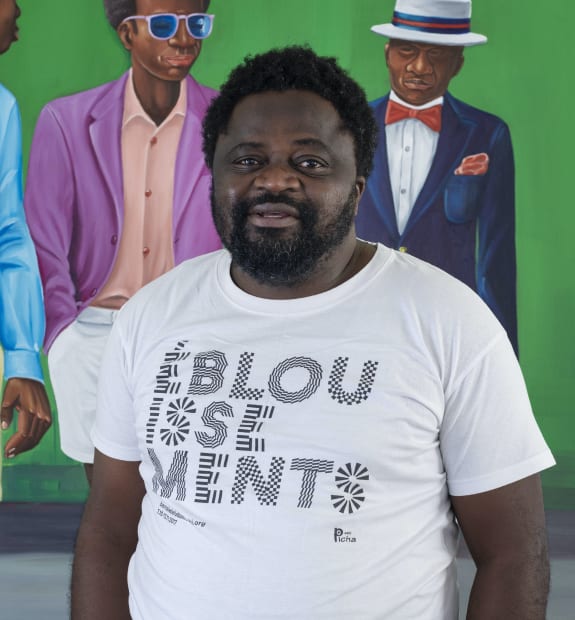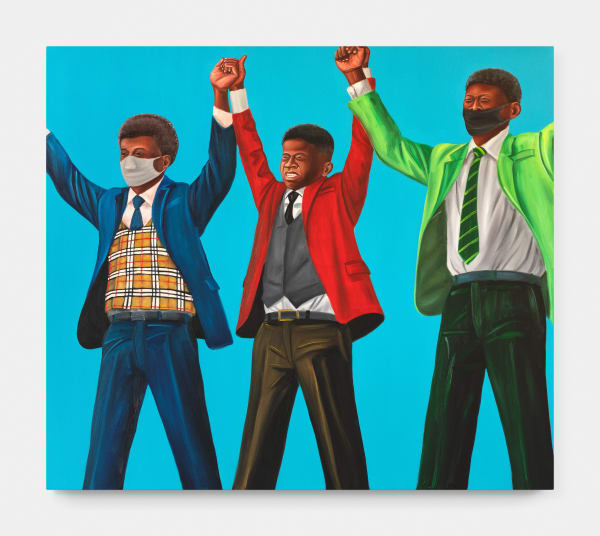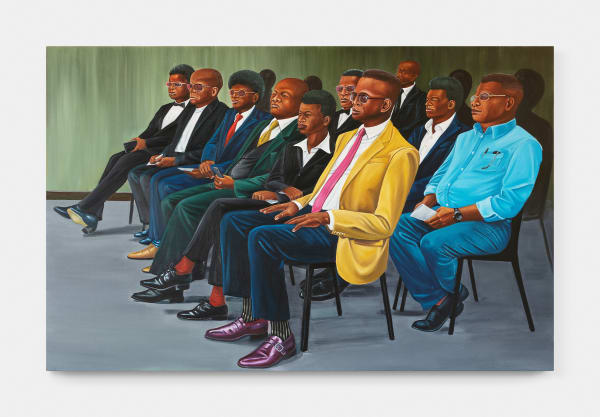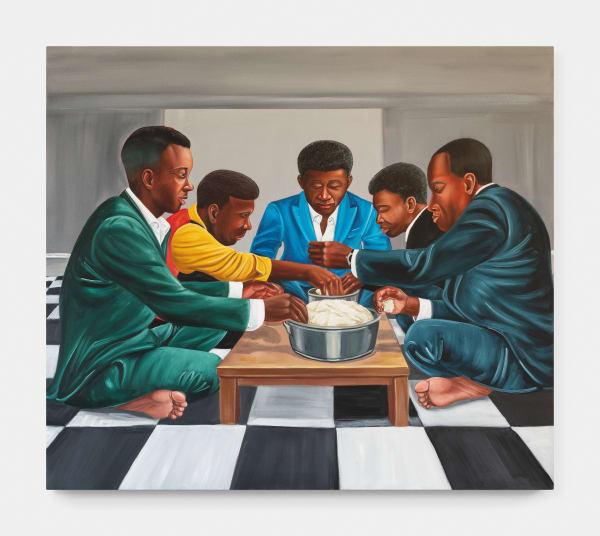-
Zemba Luzamba
In The Name Of... -

-
-
Solo exhibitions include (Upcoming) In the Name of…, Kristin Hjellegjerde Gallery, London, UK (2022); Connecxion, EBONY/CURATED Cape Town, South Africa (2019); Déjà vu at the 5th Picha Biennale de Lubumbashi, DR Congo (2017); In The South – Paintings from 2004-2017, Stellenbosch University Museum, South Africa (2017); Genesis, EBONY/CURATED, Franschhoek, South Africa (2016); It Is What It Is, EBONY/CURATED, Cape Town, South Africa (2015); LA SAPE, AVA Gallery, Cape Town, South Africa (2013); LA SAPE, AVA Gallery, Cape Town, South Africa (2012); Hope for Refugees, Rome, Italy (2005); Untitled, AVA Gallery, Cape Town, South Africa (2004).
Group exhibitions include When We See Us, Zeitz Museum of Contemporary Art Africa (Zeitz MOCAA), South Africa (2022); Shout Plenty, the African Artists Foundation, Lagos, Nigeria (2022); AAGA annual African Galleries Now online edition powered by Artsy, Africa (2022); A Very Loop Street Summer, EBONY/CURATED, Cape Town, South Africa (2021); Everything Was Beautiful and Nothing Hurt, FNB Art Joburg, Open City, Keyes Art Mile, Rosebank, Johannesburg, South Africa (2021); 1-54 Contemporary African Art Fair, EBONY/CURATED booth, London, England (2021); 8 by 8, EBONY/CURATED, Cape Town, South Africa (2021); Investec Cape Town Art Fair, Virtual Representation, EBONY/CURATED, Cape Town, South Africa (2021); 1-54 Contemporary African Art Fair, (Virtual Representation) EBONY/CURATED, New York, US (2021); In [the] Loop, EBONY/CURATED, Cape Town, South Africa (2021); FNB Art Joburg online edition, Main Booth, Johannesburg, South Africa (2020); Intersect Chicago online edition of SOFA Expo, Chicago, US (2020); AKAA (Also Known as Africa) 2019, Paris, France (2019); A Smaller Scale, EBONY/CURATED, Cape Town, South Africa (2019); Investec Cape Town Art Fair, EBONY/CURATED, Cape Town, South Africa (2019); The Summer Exhibition, EBONY/CURATED, Cape Town, South Africa (2018); From the Horse’s Mouth, EBONY/CURATED, Cape Town, South Africa (2017); Beyond Binaries, Durban Art Gallery, Durban, South Africa (2016); That Art Fair, Cape Town, South Africa (2015); In Print/In Focus, Michealis Galleries, Cape Town, South Africa (2015).
-
Highlights and Collections
Luzamba’s work can be found in international private and public collections, including Durban Art Gallery (South Africa), Irma Stern Museum (South Africa), Nandos Art Collection (UK), Nandos Art Collection (South Africa), Scalabrini House (Italy), Cultures Inc (US), Museum of Modern Art (Equatorial Guinea) Jorge M. Pérez Collection (US), Fondation H Museum (Madagascar); The Bunker Art Space (Beth Rudin DeWoody Collection) (USA), UTA Artist Space Collection (USA) .
-
-

-
-
Luzamba notes down the ideas for his paintings in a dated diary – this might include details of a particular image or scene, or the title of the work. He then sketches a rough composition onto a hand drawn grid, which is perfected through multiple iterations. The drawings are made first in pencil and then worked over with pen to create definitive, bold lines, however, colour is only introduced on the canvas. ‘The colours come naturally to me when I am painting. In a way, they represent the personal, emotional connection that I have with the initial concept,’ he explains. While the colours used in the background might hint at a certain atmosphere or mood, they also create a visual contrast, propelling the figures into the foreground in a way that almost confronts the gaze. In the painting La Resistance, for example, four, flamboyantly dressed figures stand proudly with their fists raised in the air against a white background. Their hand gesture is a universally recognisable symbol for fighting oppression, made bolder against the blankness of the background which, in turn, allows the viewer the freedom to interpret the narrative through the lens of their own experiences.
While Luzamba’s scenes might appear cinematic and graphical in style, his figures are never merely stereotypes. In La Resistance, the figures are facing out towards the viewer, but our gaze is only met directly by the woman. The men are wearing reflective sunglasses that hide their eyes, and the postures of their bodies are more casual, while the woman’s body language conveys a sense of strength and conviction. Their clothing is also an expression of their individuality. The men, as in almost all of the paintings in the exhibition, are dressed in suits and ties, making reference to a Congolese sub-culture known as SAPE (the Société des Ambianceurs et des Personnes Élégantes) that emerged in the 1960s and 70s when President Mobutu banned the wearing of Western-style style suits in favour of the abacost, a lightweight suit which was traditionally worn without a tie. The abacost was seen as the uniform of Mobutu's supporters, especially those who had benefited from his regime. ‘When I was growing up, the only people you’d see wearing a suit and tie were foreigners or actors in movies. To wear that kind of clothing became a symbol of resistance and freedom. It still has that association for me and for many Congolese,’ says Luzamba. This context imbues less explicitly political works such as Karibu ku meza – which depicts a group of men sitting cross-legged on the floor sharing bowls of bukari (otherwise known as fufu, a staple of African food made from cassava, ground maize or corn) – with a further layer of significance as we understand their choice of clothing as an expression of defiance, but crucially, the scene is also relatable without this knowledge.
-
Indeed, in Luzamba’s work, there is a sense of stripping away the noise and excess to refocus our attention on the body – not just the bodies of the figures he paints, but also our own. By observing the subtle physical gestures and facial expressions of Luzamba’s protagonists, we also embody the action portrayed and thus, form a deeper, more personal, and lasting connection to the image. Just as the ellipsis in the title creates space for the viewer to insert their own narrative, the paintings invite us to not just witness, but experience a sense of creative freedom.
-
-
-
Zemba Luzamba : In The Name Of..,
Past viewing_room
















